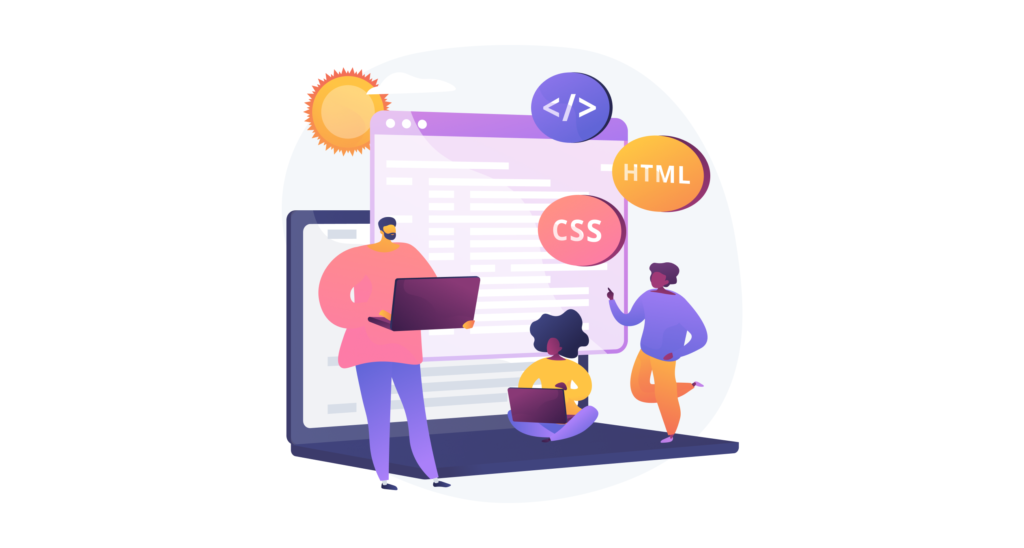What the Future Holds for Frontend Development for Startups

Table of Contents
Front end development is important for the success of a business since it involves implementing user-friendly and efficient digital experiences. The front end is the face of your product for startups as it is where clients engage with your brand initially. Your company's reputation may be made or broken by the way your app or website functions, looks, and acts. Users tend to vote in a matter of seconds, therefore your site's speed, usefulness, and design are crucial.
This program goes beyond appearances to improve the user experience in order to boost engagement and conversion. You can better convey your brand identity, maintain user engagement, and build trust with a robust front end. This part will cover frameworks and technologies that may help you bring your ideas to life, as well as the significance of front-end development for entrepreneurs. To start, let's examine what front-end development is in more detail.
Understanding Front End Development
All user interface elements of a website or online application are included in front-end development. Although the phrase is frequently linked to visual design, its scope is far more extensive. Code is used by front-end developers to design the presentation (CSS), provide interaction (JavaScript), and organize the content (HTML). The process of converting a digital product's design into a useful user interface is known as front-end development.
Front end development includes all of a website's or online application's user interfaces. The term has a far wider meaning, even though it is frequently connected to painting. Front-end developers utilize code for internal structure (HTML), display (CSS), and interaction (JavaScript). Front-end development is the process of converting a digital product's design into a functional user interface.
Key Components of Front-End Development
A lot of crucial elements work together in front-end development to provide a positive user experience:
- Performance Optimization: To speed up load times and ensure flawless performance, front-end developers employ efficient coding strategies and reduce file sizes.
- Cross-Browser Compatibility: To provide consumers with a uniform experience, a front-end developer ensures that the website works and looks the same across all major browsers and devices.
- Accessibility: It's also challenging to make your website accessible to all users by including features like keyboard navigation and screen reader compatibility.
- UI Implementation: Front-end developers convert the design files into usable, responsive, and interactive user interfaces that stay faithful to the original idea.
- API Integrations: Developers frequently connect third-party services like payment gateways and social network sharing to improve user experience and boost speed.
- Security: To safeguard user data and guard against vulnerabilities like cross-site scripting (XSS), front-end developers use security measures.
These elements not only make the front end look great but also ensure that it is safe, functional, and useful.
Essential Technologies in Front-End Development
Front end development makes use of a range of tools and methods to give consumers an easier-to-use interface. Based on the following essential technologies and procedures, modern face development is constructed.
HTML, CSS, and JavaScript: The Building Blocks of Web Development
- HTML (Hypertext Markup Language): HTML is the foundation of web development. It serves as the cornerstone of each webpage and arranges all online information, including text, photos, links, and videos.
- CSS (Cascading Style Sheets): CSS is used to manage how web pages look. This general respect to layout, color, font, and style makes the text simple and visually appealing. The layout of various screen sizes may be altered using CSS, another important tool used by responsive design concepts.
- JavaScript: JavaScript is a computer language that makes websites dynamic. It helps for developing feature-rich, contemporary websites that leverage active content manipulation and user interactions like JavaScript clicks and form submissions to make the online experience more engaging.
Frameworks and Libraries: React, Angular, and Vue.js
Frameworks and libraries speed up development and increase process efficiency by providing reusable components and pre-written code.
- React: Developers may construct dynamic, high-performance user interfaces with Facebook's React JavaScript package by decomposing the user interface into reusable pieces. It is renowned for its quickness, adaptability, and wonderful community.
- Angular: Google has created Angular, a feature-rich front-end framework that offers a comprehensive solution for creating intricate applications. Large-scale, corporate applications can benefit from its integrated data binding, state management, and portability technologies.
- Vue.js: Vue is a scalable and lightweight JavaScript framework for building interactive user interfaces and single-page apps. Developers have access to powerful capabilities like two-way data binding and component-based design, and interacting with other projects is simple.
The primary comparison between React vs Vue.js is meant to help you in selecting the ideal frontend framework for current web development.
The ideal system or library will depend on your company's requirements, size, and complexity. Vue provides a lighter, more adaptable option, Angular is ideal for bigger applications, and React is ideal for dynamic, interactive interactions.
Responsive Design Technologies - Importance of Mobile Optimization:
Due to the growing number of people using mobile devices to access websites, it can be challenging to ensure that your website is responsive to various screen sizes and resolutions.
- Media Queries: Options depending on screen size or device type may be created using these CSS options. It is easier to program PCs, tablets, and smartphones when media queries are used.
- Flexbox and Grid Layout: CSS Grid Layouts and Flexbox offer sophisticated techniques for building responsive, complicated layouts without float or positioning. These characteristics help in the creation of scalable, intuitive images that adapt to different screen sizes.
- Mobile-First Design: With a priority on mobile devices, this design makes sure webpages are first optimized for smaller screens before scaling up for bigger ones.
Functionality is just as extremely important as design when it comes to mobile optimization. To improve load speed, even on slow mobile connections, front-end engineers optimize scripts and images.
Version Control Systems - Git and Collaboration Tools:
When many developers work together on a project, version control is especially important for managing changes to the website's codebase. Git is the most widely used version control system, allowing developers to work together, log changes to the code, and revert to previous iterations with ease.
- GitHub and GitLab: With the help of these tools, developers may collaborate on projects, save their code, and keep an eye out for issues and defects in cloud-based repositories. GitHub in particular offers powerful collaboration tools that speed up the development process, such as pull requests and code reviews.
- Branching and Merging: With Git, developers may work on many features simultaneously in different branches, which are then merged into the main project. Because of this process, collaboration goes well and problems are avoided.
Maintaining effective procedures and high-quality code requires the use of Git and other version control systems in addition to collaborative platforms like GitHub.
The Role of Front-End Development in Startups
Making a good first impression might be important in the startup environment. Customers, investors, and partners frequently view your website or app first, so a beautiful, quick, and user-friendly interface makes the site appear clear, well-designed, and encourages them to remain longer and make more demands. Additionally, it is uplifting as it boosts confidence right away. It's crucial to provide a polished experience because visitors form an opinion in as little as 0.05 seconds.
You need a front-end for a good user experience (UX). It guarantees that your website or app is easy to use, quick to install, and compatible with all devices. Effective user experience design increases user engagement, conversions, and bounce rates. Businesses may boost brand loyalty and client retention by creating a user experience (UX) that makes their products more enticing and easily accessible.
Benefits of High-Quality Front-End Development

Brand Awareness and Identity
How customers perceive your business is significantly impacted by the way your website or app is designed. Effective front-end development guarantees that the layout, color scheme, typography, and overall design all successfully and consistently represent your brand identity. A website with an elegant and well-designed front end is frequently found by visitors, and it also encourages brand identification. It increases visibility when utilized correctly, which facilitates communication and builds trust in your business.
Performance Optimization
One of the key components of frontline development is performance improvement. Faster loading times for websites or apps keep consumers happy and interested. An overly extended loading time increases the likelihood that people may quit your site. Optimizing pictures, reducing code, and employing strategies like lazy loading can result in much faster load times, which can enhance user experience and retention. Combining improved, quicker performance with more client interest raises SEO ranks and expands the visibility of your business.
Trust and Credibility
Users will probably feel more secure knowing that the UI is well-structured and attractive. Your company's efficiency, navigability, and attractiveness all contribute to a positive perception of it. A website is more likely to be trusted by users if it functions effectively, appears professional, and is simple to use. A badly designed website or one that loads slowly, on the other hand, might have unsettling outcomes and make potential clients doubt your legitimacy. In addition to encouraging visitors to do desired activities like registering, purchasing, or sharing information, good front-end design also helps establish your business as reliable.
Cost-Effectiveness of Outsourcing Front-End Development
Due to front-end enhancements, outsourcing may drastically cut expenses for companies. Rather than hiring full-time contractors with wages, benefits, and other expenses, outsourcing enables you to pay just for the services that are absolutely necessary. For businesses with limited funds, this can be a cost-effective solution because it can save expenses for office space, technological infrastructure, and hiring. Additionally, startups have the option to separately outsource critical functions like marketing or production.
Businesses may get skilled developers with an importance on front-end technologies through outsourcing. This eliminates the need to invest time and resources in training new hires or hire full-time staff. Outsourcing provides flexibility without the inconvenience of long-term commitments for one-time tasks or ongoing improvement. The team may be resized to fit your project's needs, guaranteeing that you have the appropriate people on board at the right time while minimizing expenses.
Competitive Advantage Through Quality Development
High-quality front-end development may accelerate the introduction of a product or service, giving companies a major competitive advantage. By delegating the front-end to skilled developers, you may expedite the development process and guarantee quicker delivery without sacrificing usability or functionality. Because of this short turnaround time, companies may launch their product earlier and begin drawing users, collecting feedback, and making changes before competitors can catch up.
Startups need to maintain flexibility in order to be competitive in the ever-changing digital market. More flexibility is made possible by top-notch front-end development, which enables your website or app to swiftly adjust to shifting user preferences, market demands, or emerging trends. A solid front-end foundation makes it simpler to update or pivot your product, whether that means adding new features, improving the user experience, or optimizing for new devices. This ensures that your company can maintain its lead in a market that is changing quickly.
React vs Angular, explore which front-end framework is the best fit for your next project’s needs.
Common Challenges Faced by Startups in Front-End Development
Startups frequently work with constrained time and financial resources. Due to these limitations, investing in the newest tools and technologies or hiring a whole in-house development staff may be challenging. Because of this, many businesses struggle to exceed user expectations while maintaining a high-quality front-end within their financial limitations. Hiring independent developers or outsourcing can help mitigate this problem, but it also necessitates rigorous supervision to guarantee that the work is in line with the objectives and vision of the business.
It might be difficult to strike a compromise between the requirement for high-quality front-end development and economical constraints because startups usually have limited resources. Development shortcuts used for financial reasons may eventually result in poor user experience, performance problems, or even security flaws. However, making significant investments in top-tier development might divert resources that would be better used for other important areas like product innovation or marketing. Maintaining the front end's functionality, responsiveness, and efficiency while staying within the startup's budget requires striking a compromise between cost and quality.
How to Choose the Right Front-End Development Partner
When selecting a front-end development partner for your business, there are some crucial factors to take into account. Verify first that the partner is skilled in cutting-edge technologies like HTML, CSS, and JavaScript, as well as modern frameworks like React, Angular, or Vue.js. Because they will be more exposed to the basic difficulties of limited funding, quick turnaround times, and feasibility criteria, previous expertise with start-ups is particularly crucial. Communication and other relevant factors Your partner must be helpful, truthful, and responsive in order for you to make your argument.
Conclusion
For any startup hoping to be successful, front-end development is important. The front-end quality of your website or app has an immediate effect on user retention, brand perception, and overall company performance since consumers develop opinions in a matter of seconds. Investing in a smooth, responsive, and eye-catching front-end as a business may increase engagement and help you stand out in a crowded industry.
Our specialty at Patoliya Infotech is providing outstanding front-end development services that complement your particular company objectives. Our team has years of expertise developing creative, responsive, and user-friendly digital solutions that function flawlessly on a variety of devices. We aim to provide scalable, high-performing solutions that are customized to meet your needs because we recognize the value of both functionality and aesthetics.
Contact Patoliya Infotech right now for skilled front-end development services that can boost your brand and drive expansion if you're searching for a trustworthy partner to create a unique online experience.



